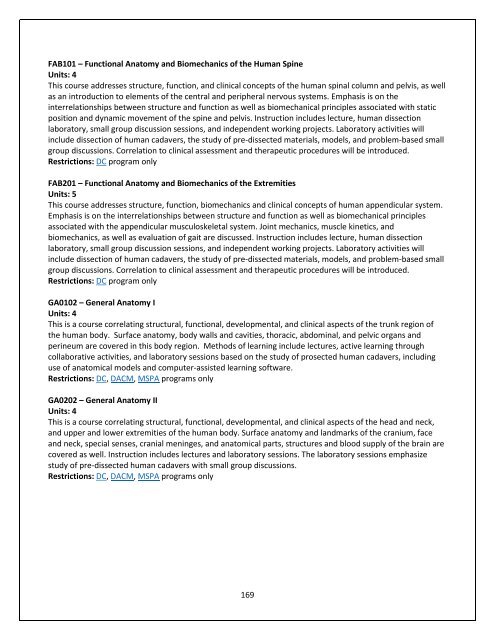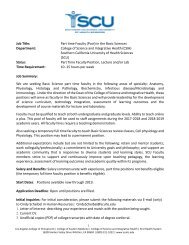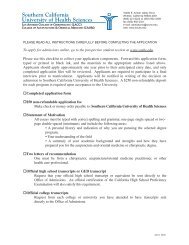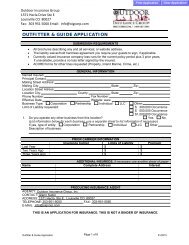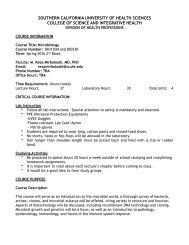Vision, Mission, and Guiding Principles for SCUHS
Southern California University of Health Sciences will be recognized as the premier evidence-based integrative healthcare university. in this PDF we are discussing about our Vision, Mission, and Guiding Principles. Please have a look. you can also go with this link: https://bit.ly/2JuIItL
Southern California University of Health Sciences will be recognized as the premier evidence-based integrative healthcare university. in this PDF we are discussing about our Vision, Mission, and Guiding Principles. Please have a look. you can also go with this link: https://bit.ly/2JuIItL
You also want an ePaper? Increase the reach of your titles
YUMPU automatically turns print PDFs into web optimized ePapers that Google loves.
FAB101 – Functional Anatomy <strong>and</strong> Biomechanics of the Human Spine<br />
Units: 4<br />
This course addresses structure, function, <strong>and</strong> clinical concepts of the human spinal column <strong>and</strong> pelvis, as well<br />
as an introduction to elements of the central <strong>and</strong> peripheral nervous systems. Emphasis is on the<br />
interrelationships between structure <strong>and</strong> function as well as biomechanical principles associated with static<br />
position <strong>and</strong> dynamic movement of the spine <strong>and</strong> pelvis. Instruction includes lecture, human dissection<br />
laboratory, small group discussion sessions, <strong>and</strong> independent working projects. Laboratory activities will<br />
include dissection of human cadavers, the study of pre-dissected materials, models, <strong>and</strong> problem-based small<br />
group discussions. Correlation to clinical assessment <strong>and</strong> therapeutic procedures will be introduced.<br />
Restrictions: DC program only<br />
FAB201 – Functional Anatomy <strong>and</strong> Biomechanics of the Extremities<br />
Units: 5<br />
This course addresses structure, function, biomechanics <strong>and</strong> clinical concepts of human appendicular system.<br />
Emphasis is on the interrelationships between structure <strong>and</strong> function as well as biomechanical principles<br />
associated with the appendicular musculoskeletal system. Joint mechanics, muscle kinetics, <strong>and</strong><br />
biomechanics, as well as evaluation of gait are discussed. Instruction includes lecture, human dissection<br />
laboratory, small group discussion sessions, <strong>and</strong> independent working projects. Laboratory activities will<br />
include dissection of human cadavers, the study of pre-dissected materials, models, <strong>and</strong> problem-based small<br />
group discussions. Correlation to clinical assessment <strong>and</strong> therapeutic procedures will be introduced.<br />
Restrictions: DC program only<br />
GA0102 – General Anatomy I<br />
Units: 4<br />
This is a course correlating structural, functional, developmental, <strong>and</strong> clinical aspects of the trunk region of<br />
the human body. Surface anatomy, body walls <strong>and</strong> cavities, thoracic, abdominal, <strong>and</strong> pelvic organs <strong>and</strong><br />
perineum are covered in this body region. Methods of learning include lectures, active learning through<br />
collaborative activities, <strong>and</strong> laboratory sessions based on the study of prosected human cadavers, including<br />
use of anatomical models <strong>and</strong> computer-assisted learning software.<br />
Restrictions: DC, DACM, MSPA programs only<br />
GA0202 – General Anatomy II<br />
Units: 4<br />
This is a course correlating structural, functional, developmental, <strong>and</strong> clinical aspects of the head <strong>and</strong> neck,<br />
<strong>and</strong> upper <strong>and</strong> lower extremities of the human body. Surface anatomy <strong>and</strong> l<strong>and</strong>marks of the cranium, face<br />
<strong>and</strong> neck, special senses, cranial meninges, <strong>and</strong> anatomical parts, structures <strong>and</strong> blood supply of the brain are<br />
covered as well. Instruction includes lectures <strong>and</strong> laboratory sessions. The laboratory sessions emphasize<br />
study of pre-dissected human cadavers with small group discussions.<br />
Restrictions: DC, DACM, MSPA programs only<br />
169


